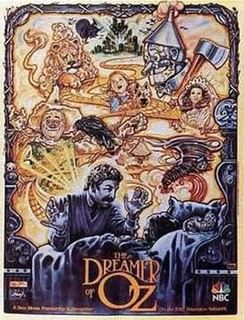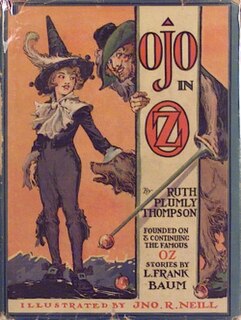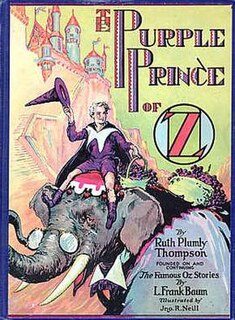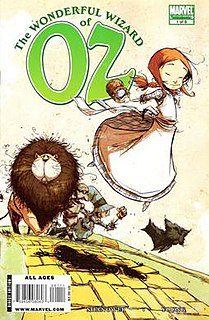 W
WAfter the Wizard is an independent 2011 fantasy film written and directed by Hugh Gross, based on the 1900 novel The Wonderful Wizard of Oz by L. Frank Baum. The film premiered in 2011 in Kingman, Kansas. The DVD, distributed by Breaking Glass Pictures, was released on August 7, 2012.
 W
WA Barnstormer in Oz: A Rationalization and Extrapolation of the Split-Level Continuum is a 1982 novel by Philip José Farmer and is based on the setting and characters of L. Frank Baum's The Wonderful Wizard of Oz.
 W
WCaptain Salt in Oz (1936) is the thirtieth in the series of Oz novels created by L. Frank Baum and his successors, and the sixteenth written by Ruth Plumly Thompson. It was illustrated by John R. Neill.
 W
WThe Deadly Desert is the magical desert that completely surrounds the fictional Land of Oz, which cuts it off from the rest of the world.
 W
WThe Dreamer of Oz: The L. Frank Baum Story is a 1990 American made-for-television biographical film starring John Ritter as Lyman Frank Baum, the author who wrote the 1900 novel The Wonderful Wizard of Oz and thirteen other Oz books. Also starring in it was Annette O'Toole as Baum's supportive wife, Maud, and Rue McClanahan as Baum's tough mother-in-law, Matilda Gage. John's son, Jason Ritter, makes his debut in it as Harry Neal Baum. At the time of its debut, O'Toole and Ritter also starred in It, a TV miniseries where they played a couple.
 W
WThe Emerald Wand of Oz is a 2005 book by Sherwood Smith and is a continuation of the Oz series that was started by L. Frank Baum in 1900 and continued by his many successors. The book is illustrated by William Stout and published by Harper Collins.
 W
WGrampa in Oz (1924) is the eighteenth in the series of Oz books created by L. Frank Baum and his successors, and the fourth written by Ruth Plumly Thompson.
 W
WThe Hidden Prince of Oz is a novel written by Gina Wickwar and illustrated by Anna-Maria Cool. As its title indicates, the book is an entrant into the series of Oz books by L. Frank Baum and his many successors.
 W
WIx is a fictional region in The Oz series of novels created by L. Frank Baum. It neighbors the Land of Oz and Noland, and is ruled by the centuries-old witch-queen Zixi.
 W
WKabumpo, the Elegant Elephant of Pumperdink, is a fictional character in the Oz books of Ruth Plumly Thompson.
 W
WKabumpo in Oz (1922) is the sixteenth Oz book, and the second written by Ruth Plumly Thompson. It was the first Oz book fully credited to her.
 W
WLucky Bucky in Oz (1942) is the thirty-sixth in the series of Oz books created by L. Frank Baum and his successors, and the third and last written and illustrated solely by John R. Neill.
 W
WThe Making of the Wizard Of Oz, written by film historian Aljean Harmetz, is a book about the production of the 1939 film The Wizard of Oz. It was the second book published documenting the making of this film, released a year after Doug McClelland's 1976 work Down the Yellow Brick Road.
 W
WMerry Go Round in Oz (1963) is the fortieth in the series of Oz books created by L. Frank Baum and his successors. It was written by Eloise Jarvis McGraw and Lauren McGraw Wagner. It was illustrated by Dick Martin.
 W
WMister Tinker in Oz is an apocryphal Oz book, authored by James Howe and published in 1985 by Random House involving an inventor responsible for Tik-Tok the Clockwork man and Dorothy and their adventure in Oz.
 W
WOjo in Oz (1933) is the twenty-seventh in the series of Oz books created by L. Frank Baum and his successors, and the thirteenth written by Ruth Plumly Thompson. It was illustrated by John R. Neill.
 W
WOjo is a character from the fictional Oz book series by L. Frank Baum.
Prince Silverwings and Other Stories is a 1902 children's book by Edith Ogden Harrison. The book is best known because she collaborated with L. Frank Baum on an uncompleted stage adaptation of the book as a musical extravaganza. Baum composed music for the play as well, and at least one of these songs, "Down Among the Marshes," survives and has been recorded by James Patrick Doyle on his 1999 album, Before the Rainbow: The Original Music of Oz, and Baum scholar Michael O. Riley published a complete edition of their Scenario and General Synopsis for the play through the Pamami Press in 1982 in a limited run of 125 copies in white cloth bound in purple with illustrations by Dick Martin. It is otherwise known only from a typescript in the Chicago Historical Society.
 W
WThe Purple Prince of Oz (1932) is the 26th in the series of Oz books created by L. Frank Baum and his successors, and the 12th written by Ruth Plumly Thompson. It was illustrated by John R. Neill.
 W
WThe Silver Princess in Oz (1938) is the thirty-second of the Oz books created by L. Frank Baum and his successors, and the eighteenth written by Ruth Plumly Thompson. It was illustrated by John R. Neill.
 W
WSpeedy in Oz (1934) is the twenty-eighth in the series of Oz books created by L. Frank Baum and his successors, and the fourteenth written by Ruth Plumly Thompson. It was Illustrated by John R. Neill.
 W
WTrouble Under Oz is a 2006 novel by Sherwood Smith, illustrated by William Stout and published by Harper Collins. It is a sequel to Smith's 2005 novel The Emerald Wand of Oz which is a further continuation of the Oz series originally started by L. Frank Baum in 1900.
 W
WThe Wishing Horse of Oz (1935) is the twenty-ninth in the series of Oz books created by L. Frank Baum and his successors, and the fifteenth written by Ruth Plumly Thompson. It was Illustrated by John R. Neill. This book marked the point at which Thompson had written more Oz books than Baum himself.
 W
WThe Wonderful Wizard of Oz (2005) is a collection of three stories adapting the novel The Wonderful Wizard of Oz (1900) by L. Frank Baum. The stories were written by David Chauvel with art by Enrique Fernandez.
 W
WThe Wonderful Wizard of Oz (2009) is an eight-issue comic book limited series adapting the L. Frank Baum novel of the same name. The series was written by Eric Shanower with art by Skottie Young and published by Marvel Comics.
 W
WThe Yellow Knight of Oz (1930) is the twenty-fourth in the series of Oz books created by L. Frank Baum and his successors, and the tenth written by Ruth Plumly Thompson. It was illustrated by John R. Neill.